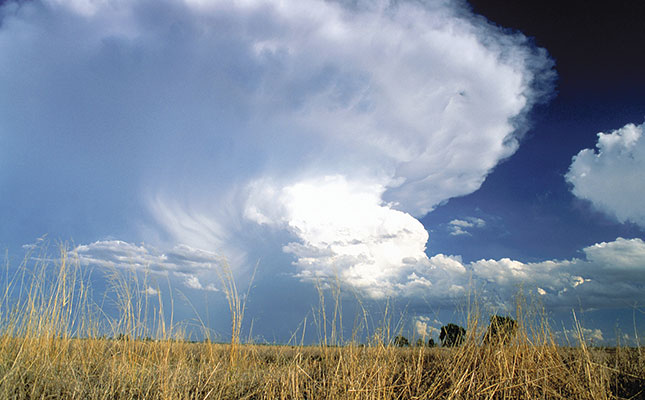A grim glimpse into the winter rainfall region’s future
The good news is that rainfall conditions for most of the summer rainfall region are likely to improve from mid- to late summer. The bad news is that drought conditions are expected to continue in the winter rainfall region. This is according to Johan van den Berg, manager of Specialised Crop Insurance at Santam Agriculture.
 According to Johan van den Berg, it is highly likely that South Africa’s summer rainfall region will experience good rainfall during the next two to three seasons.
According to Johan van den Berg, it is highly likely that South Africa’s summer rainfall region will experience good rainfall during the next two to three seasons.Photo: FW Archive
Some parts of the country, particularly the Western Cape, are still experiencing severe drought. To what extent can we link this drought to climate change?
The climate of South Africa varies between extremes. Drought in South Africa is part of the climate or ‘long-term expectancy’.
There are various factors contributing to the current drought situation in the Western Cape. The first is climate variability, where it is normal for drought to be experienced.
It is not uncommon for consecutive dry years or years with below-average rainfall to occur.
In the case of the Western Cape, three- to eight-year spells of below-average rainfall have been experienced over the past decades.
Take, for example, the drought spells of 1966 to 1973, 1978 to 1980, 1998 to 2006, and from 2014 until now.
The second factor may be climate change, but this is to a lesser extent. If the past 60 years are analysed, there are indications that the Western Cape is becoming drier.
The third factor involves people, namely the number of water users and the patterns of water use. In addition, the expectation of constant water flow or rainfall has contributed towards a discrepancy between the available water resources [from rainfall] and water use.
Above-average rainfall occurred over the Western Cape from 2007 until 2014, with the exception of 2012, and this became the ‘new norm’ of water supply. As such, provincial planning took into account only the good rainfall years.
When is the drought likely to break?
South Africa experiences drought more often than not; it is just the location that varies. The current drought is concentrated towards the Western Cape, Eastern Cape and south- western parts of the Northern Cape.
The drought conditions experienced since 2014 over most of the summer rainfall region became less intense during the past season, with average to above-average rainfall.
Looking ahead, it seems that the summer rainfall region will most probably enter a wet cycle in years to come, while it seems unlikely that the current drought conditions will change within a season or even two in the winter rainfall region.
What is the precipitation forecast for the winter and summer rainfall regions in 2018?
El Niño conditions are usually associated with improved rainfall conditions for the
Western Cape, while La Niña conditions usually result in below-average conditions.
The current outlook for the season until next winter is more towards La Niña, indicating that below-average conditions are likely to occur.
We’re currently already in a weak La Niña situation. The development was relatively late in the season, but it’s likely to continue until the end of the summer season to the winter of 2018.
La Niña will most likely result in favourable rainfall conditions for most of the summer rainfall region in mid- to late summer.
There are other factors, however, that can change the situation quickly. Average to above-average rainfall is likely to occur over most of the summer rainfall region due to the presence of La Niña.
It’s possible, though, that drier conditions could occur in February to March 2018 over the eastern parts of the country, but improve conditions for the western parts of the country.
South Africa experienced adverse weather conditions in 2017, including flash floods and hailstorms. To what can these be attributed, and can the country expect more of the same?
South Africa is experiencing more adverse weather conditions, and changes in demographics may be part of the reason for this.
As the population has increased over time, and the number of people is more concentrated in specific areas, the chances of damage from a hailstorm, for example, have increased.
If a hailstorm occurred in Gauteng, say, 50 years ago, the probability of it hitting an area where damage was possible was considerably smaller when compared with today. This is a result of urban and rural development.
However, looking at figures from the crop insurance industry, the incidence of hail damage over the past decade is, in fact, lower than in decades before.
This may be a result of the drier conditions experienced in some years, but there is no evidence of an increase in hail damage in recent years.
In general, what are your thoughts about the weather outlook for South Africa in 2018?
With the improved probability for rain over the summer rainfall region, especially in
the traditional hot summer months, it is expected that temperatures will be lower
due to expected rainfall and cloud cover.
There are also indications that the summer rainfall region will be entering a period of a few years of improved rainfall.
However, it is highly uncertain, and even unlikely, that 2018 will see improved rainfall in the winter rainfall region.
Johan van den Berg is the manager of specialised crop insurance at Santam and is based in Bloemfontein. Email him at [email protected].
